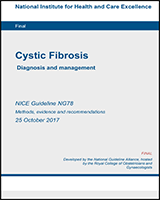| Structure | | |
|---|
| Statement of decision problem / objective | P | Decision problem stated clearly in title of review question, and clarified in the model structure section |
| Justification of modelling approach | P | Model structure justified with reference to clinical expert opinion |
| Statement of scope / perspective | P | No statement of scope, but table of contents makes scope explicitly clear so there is no risk of ambiguity |
| Structural assumptions | P | Assumptions justified in section ‘Model structure’, and clinical relevance confirmed with Guideline committee. Various structural assumptions relating to particular treatments or exacerbations explained in relevant sections. |
| Strategies / Comparators | P | Very nonstandard approach to transition probabilities (see below), but otherwise structure is highly consistent with other similar models in the area |
| Model type | P | Choice of Markov Model obvious. Limitations of this model type discussed and sensible attempts to address these limitations have been made |
| Time horizon | P | Lifetime time horizon, in keeping with Reference Case |
| Health states/disease pathways | P | Health states carefully considered - especially choice of FEV states |
| Cycle Length | P | Cycle length unusual (first cycle is 9 months, subsequent cycles annual) but justified with reference to literature on short-term effects of treatment. Subsequent annual cycle length standard. |
| Parsimony | P | Structural components of the model carefully chosen to aid understanding, especially the number and extent of health states. |
| Data | | |
|---|
| Data Identification | P | Systematic review of published literature |
| Data Synthesis | P | Synthesis strategy well justified and explained. Significant difficulty with integrating rates occurring across cycles that didn’t match the model cycle length, but approach to this explained and defensible. |
| Discounting | P | 3.5% as specified in Reference Case |
| Analysis of trial data | P | Data analysed at most appropriate level |
| Treatment effects | P | Odds ratios derived from trials and superimposed on population baseline risks generated through regression model |
| Transition probabilities | P | Derivation of transitions probabilities not standard as model attempts to map a continuous process onto a discrete-state model. Nevertheless the methodology employed here is well-described, and validated by NICE TSU |
| Mortality | P | Discussion of mortality in model write-up; CF has a very poor prognosis and so life tables not appropriate. Data from Vertex used to calculate ‘all cause CF’ mortality, and lung-transplant specific mortality appended to this. Model-specific mortality rates explained and justified. |
| Extrapolation | P | Significant extrapolation, but well justified in text with reference to committee expert opinion. Not possible to validate with reference to literature, as such literature does not exist |
| Risk factors | P | Evidence of nonlinear effect of risk factors on mortality sought and incorporated into model, for example by considering lung transplant as a separate state |
| Utilities | P | Utilities described in section on health-related quality of life, and justified with reference to literature. Model clear on baseline QoL and subsequent decrements |
| Charges and costs | P | Charges and costs described in section 1.3, and come from standard sources such as NHS Reference Costs and PSSRU |
| Adjustment over time / between countries | P | Costs inflated from historic values using standard sources |
| Half-cycle correction | F | No half-cycle correction undertaken. Defensible as cycle length much shorter than model time horizon, but half-cycle correction would be preferred |
| Data incorporation | P | Choice of data to incorporate and how the data are used is clear and well-justified |
| Uncertainty | | |
|---|
| General statement regarding sensitivity analysis | P | Described fully in sections on sensitivity analysis methods and results |
| Structural | N/A | Model structure not varied as committee opinion was that the structure was an effective one for investigating the review question |
| Methodological | P | Although discount rate not varied as per Philips (2004), substantial methodological variation examined and discussed |
| Parameter | P | Parameter uncertainty well investigated - considers all relevant OWSAs that the committee suggested, and a PSA is further undertaken to reflect probabilistic uncertainty |
| Consistency | | |
|---|
| Internal | P | Model is highly robust to ‘stress testing’ such as putting extreme values into cells. Model behaves in an intuitive way, for example recommending treatments to which a substantial discount has been applied |
| External | P | Face validity confirmed with reference to Guideline committee. Additionally, values appear congruent with general clinical practice. |
| Between-model | P | Results consistent with literature on the topic, although literature is extremely sparse. |
| Predictive | N/A | Model not intended to be used predictively, and such predictive work would be well outside NICE methods manual |
